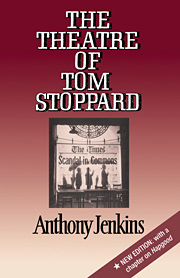3 - Victims of perspective
Published online by Cambridge University Press: 08 January 2010
Summary
The idea for The Real Inspector Hound, the one-act play that opened in London in June of 1968, also originated during the years of apprenticeship. Many of the jokes have a Goon-Show stamp, or they parody familiar clichés. Though Stoppard began the play while still in Bristol, the final version develops in purely farcical terms the ambivalence between truth and illusion that informs both Lord Malquist and Rosencrantz. But where the novel's many distorting mirrors create some narrative confusion, both plays work clearly in and out of a known structure, in this case the “who-killed-thing” plot best exemplified by Agatha Christie's The Mousetrap, which was then a mere fifteen years into its West End run. “I have enormous difficulty in working out plots, so actually to use Hamlet, or a classical whodunnit … for a basic structure, takes a lot of the pressure off me.” Hamlet itself is a sort of thriller and has its Mousetrap scene. Lord Malquist's “slim and useless volume bound in calf and marked with a ribbon” investigates Hamlet as a source of book titles (“Her Privates We”) and Moon thinks “something is rotten” with modern life. Hound has its two drama critics Birdboot and Moon, whose names echo the novel and whose attitudes are not all that far removed from the First Player's Boot and from Ros and Guil's full and half Moon. Yet all Stoppard's characters up to this point appear to have some freedom of choice. In Hound they are puppets pulled by the strings of the whodunnit or, in the critics' case, by an overwhelming ambition.
- Type
- Chapter
- Information
- The Theatre of Tom Stoppard , pp. 50 - 71Publisher: Cambridge University PressPrint publication year: 1989



